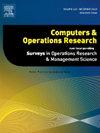二维料仓包装、切料和开维问题:实际要求调查
IF 4.3
2区 工程技术
Q2 COMPUTER SCIENCE, INTERDISCIPLINARY APPLICATIONS
引用次数: 0
摘要
二维切割和包装(C&;P)问题涉及将一个或多个物体切割成一组物品,从而产生切割图案。C&;P问题存在于各种实际应用中,如钢铁、木材、造纸和玻璃行业,其中工业方面如原材料再利用、有缺陷的物体、修剪距离、基于物品相似性的切割模式和/或需求不确定性影响解决方法的发展。这篇文章提出了一个系统的文献综述工业方面在切割相关应用的C&;P问题,特别侧重于二维箱包装,切割库存,和开放维度的问题。从100篇文章的样本中,我们确定了13个行业部门的13个关键行业方面,并强调了如何将这些方面纳入解决方法。该综述还概述了在实际应用中观察到的实际效益,并提出了一个支持实施解决方法的框架。还讨论了C&;P领域的新兴研究趋势。在解决方法的设计中考虑工业方面有助于制造业的进步,通过减少原材料浪费、削减成本和最大限度地减少产生切割图案所需的时间来提高生产效率。本文章由计算机程序翻译,如有差异,请以英文原文为准。
Two-dimensional bin packing, cutting stock, and open dimension problems: A survey of practical requirements
Two-dimensional cutting and packing (C&P) problems involve cutting one or more objects into a set of items, resulting in cutting patterns. C&P problems are found in various real-life applications such as the steel, wood, paper, and glass industries, where industrial aspects like raw material reuse, defective objects, trim distance, cutting patterns based on item similarity, and/or demand uncertainty influence the development of solving methods. This article presents a systematic literature review of industrial aspects addressed in cutting-related applications of C&P problems, with a specific focus on two-dimensional bin packing, cutting stock, and open dimension problems. From a sample of 100 articles, 13 key industrial aspects were identified across 13 industry sectors, highlighting how these aspects are incorporated into solving methods. The review also outlines practical benefits observed in real-life applications and proposes a framework to support the implementation of solving methods. Emerging research trends in the C&P area are also discussed. Considering industrial aspects in the design of solving methods contributes to advances in manufacturing, improving production efficiency by reducing raw material waste, cutting costs, and minimizing the time required to generate cutting patterns.
求助全文
通过发布文献求助,成功后即可免费获取论文全文。
去求助
来源期刊

Computers & Operations Research
工程技术-工程:工业
CiteScore
8.60
自引率
8.70%
发文量
292
审稿时长
8.5 months
期刊介绍:
Operations research and computers meet in a large number of scientific fields, many of which are of vital current concern to our troubled society. These include, among others, ecology, transportation, safety, reliability, urban planning, economics, inventory control, investment strategy and logistics (including reverse logistics). Computers & Operations Research provides an international forum for the application of computers and operations research techniques to problems in these and related fields.
 求助内容:
求助内容: 应助结果提醒方式:
应助结果提醒方式:


